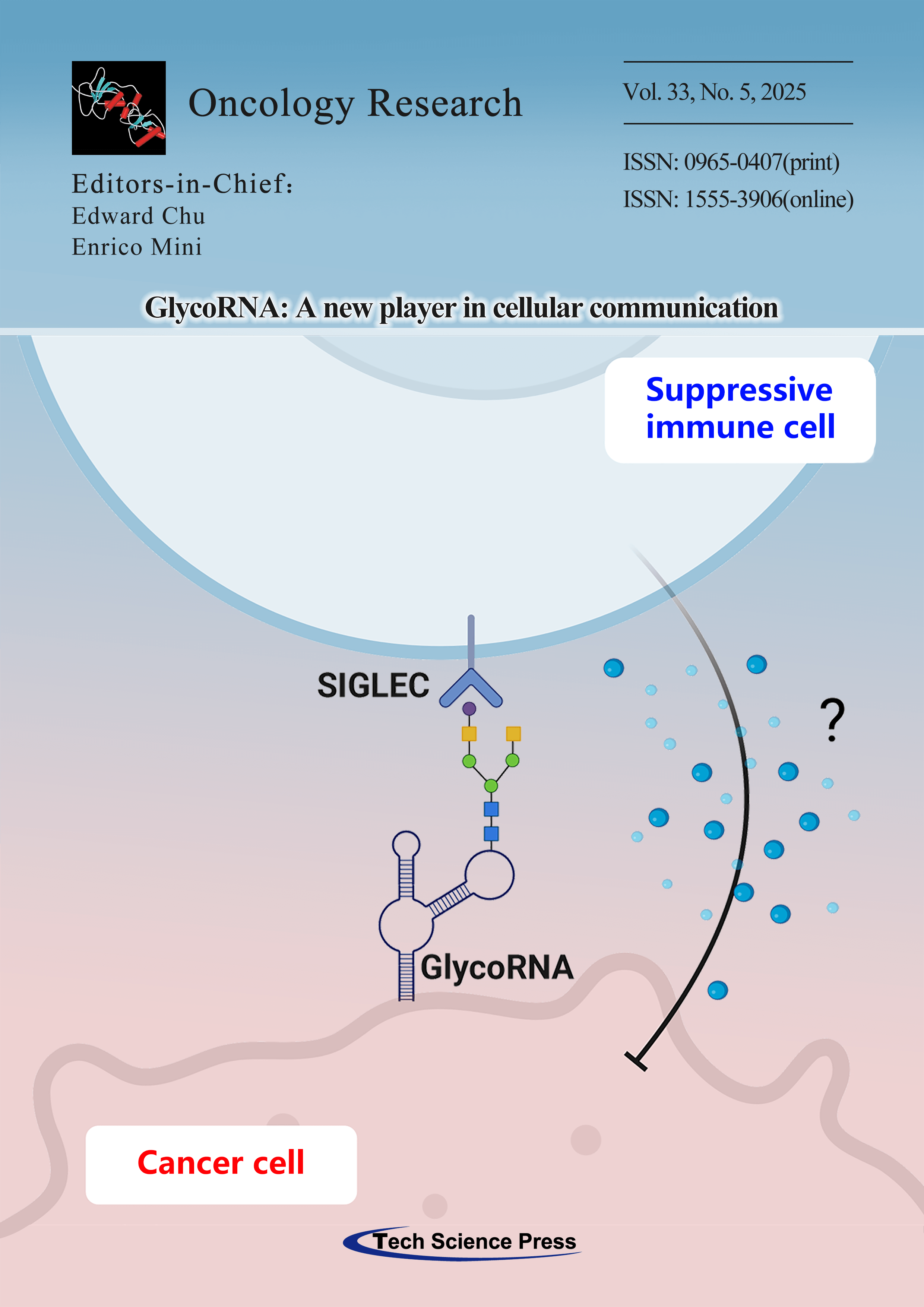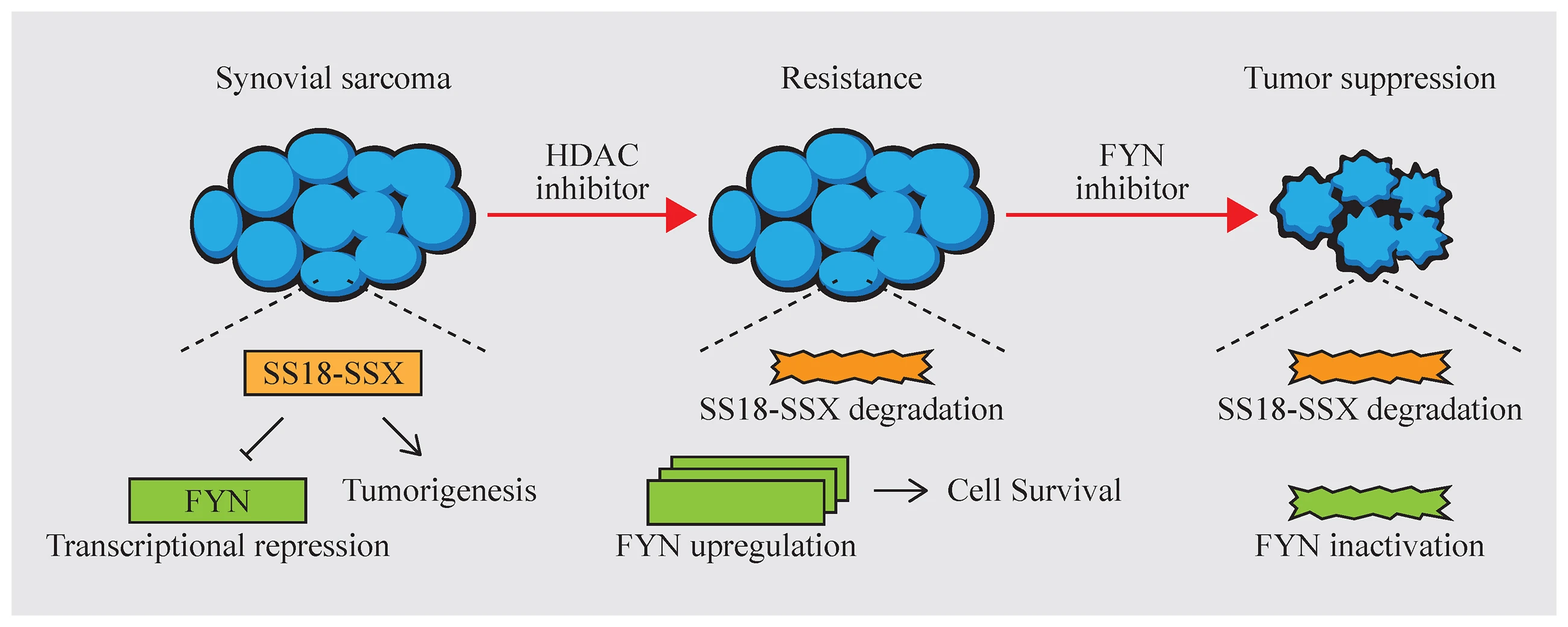
Oncology Research is committed to publishing high-quality, innovative research that is focused on the entire range of basic, translational, and clinical cancer research, with a particular interest in cancer therapeutics, providing a new platform for the understanding, prevention, diagnosis, and treatment of cancer.
Science Citation Index Expanded (Clarivate Analytics): 2023 Impact Factor: 2.0; Scopus CiteScore (Impact per Publication 2023): 4.4; SNIP (Source Normalized Impact per Paper 2023): 0.473; Embase; PubMed Central; MEDLINE; EBSCO; Google Scholar; Proquest; Portico, etc.
 Open Access
Open Access
COMMENTARY
Oncology Research, Vol.33, No.5, pp. 995-1000, 2025, DOI:10.32604/or.2025.060616 - 18 April 2025
Abstract The discovery of glycosylated RNA molecules, known as glycoRNAs, introduces a novel dimension to cellular biology. This commentary explores the transformative findings surrounding glycoRNAs, emphasizing their unique roles in cancer progression and the therapeutic opportunities they present. GlycoRNAs, through interactions with lectins and immune receptors, may contribute to tumor immune evasion. Moreover, the therapeutic potential of this emerging knowledge includes interventions targeting glycoRNA synthesis and modulation of associated signaling pathways. By highlighting these critical insights, this commentary aims to encourage the development of innovative strategies that could improve cancer prognosis and treatment. More >
 Open Access
Open Access
VIEWPOINT
Oncology Research, Vol.33, No.5, pp. 1001-1005, 2025, DOI:10.32604/or.2025.060573 - 18 April 2025
Abstract Synovial sarcoma is a high-grade soft tissue malignancy characterized by a unique fusion gene known as SS18-SSX. The SS18-SSX fusion protein acts as an oncogenic driver of synovial sarcoma, and it has thus been commonly accepted that disruption of SS18-SSX function represents a therapeutic means of treating synovial sarcoma, but emerging evidence suggests that upon depletion of SS18-SSX, an anti-apoptotic signal surprisingly arises to protect synovial sarcoma cell survival. In this article, we discuss the controversial roles of SS18-SSX’s transcriptional activity in synovial sarcoma biology and outline a synergistic strategy for overcoming the resistance of More >
Graphic Abstract

 Open Access
Open Access
REVIEW
Oncology Research, Vol.33, No.5, pp. 1007-1017, 2025, DOI:10.32604/or.2025.059657 - 18 April 2025
Abstract
Malignant tumors are heterogeneous diseases characterized by uncontrolled cell proliferation, invasion, metastasis, and/or recurrence of their malignancies. In particular, cancer stem cells (CSCs) within these tumors might be responsible for the property of invasiveness and/or therapies-resistance. CSCs are a self-renewing, awfully tumorigenic subpopulation of cancer cells, which are notorious for strong chemoresistance and are frequently responsible the aggravated invasion, metastasis, and/or recurrence. Developing targeting therapies against CSCs, therefore, may be deliberated a more encouraging mission for the greater cancer therapy. Innovation for a more potent anti-CSC treatment has been required as soon as possible.… More >
Graphic Abstract

 Open Access
Open Access
REVIEW
Oncology Research, Vol.33, No.5, pp. 1019-1032, 2025, DOI:10.32604/or.2025.060601 - 18 April 2025
Abstract Background: Head and neck cancers (HNC) account for a significant global health burden, with increasing incidence rates and complex treatment requirements. Traditional diagnostic and therapeutic approaches, while effective, often result in substantial morbidity and limitations in personalized care. This review provides a comprehensive overview of the latest innovations in diagnostics and therapeutic strategies for HNC from 2015 to 2024. Methods: A review of literature focused on pe-reviewed journals, clinical trial databases, and oncology conference proceedings. Key areas include molecular diagnostics, imaging technologies, minimally invasive surgeries, and innovative therapeutic strategies. Results: Technologies like liquid biopsy next-generation sequencing… More >
 Open Access
Open Access
REVIEW
Oncology Research, Vol.33, No.5, pp. 1033-1054, 2025, DOI:10.32604/or.2024.058256 - 18 April 2025
Abstract
Lung cancer is a common cause of cancer-related death globally. The majority of lung cancer patients initially benefit from chemotherapy and immunotherapy. However, as the treatment cycle progresses and the disease evolves, the emergence of acquired resistance leads to treatment failure. Many researches have shown that non-coding RNAs (ncRNAs) not only influence lung cancer progression but also act as potential mediators of immunotherapy and chemotherapy resistance in lung cancer, mediating drug resistance by regulating multiple targets and pathways. In addition, the regulation of immune response by ncRNAs is dualistic, forming a microenvironment for inhibits/promotes More >
 Open Access
Open Access
REVIEW
Oncology Research, Vol.33, No.5, pp. 1055-1068, 2025, DOI:10.32604/or.2024.055154 - 18 April 2025
Abstract Circulating plasma cells (CPCs) in patients of plasma cell neoplasm have been an area of intense research in recent decades. Circulating tumor plasma cells (CTPCs) might represent a sub-clone of tumor cells that have exited into peripheral blood as a result of the dynamic interactions between the bone marrow (BM) microenvironment and neoplastic plasma cells. Chemokine receptors like chemokine receptor 4 (CXCR4) and integrins are known to play a role in homing and migration of plasma cells (PCs). The hypoxic microenvironment in the BM niche also contributes to their circulation through various mechanisms. In addition,… More >
 Open Access
Open Access
REVIEW
Oncology Research, Vol.33, No.5, pp. 1069-1089, 2025, DOI:10.32604/or.2025.063005 - 18 April 2025
Abstract One of the most prevalent malignant tumors worldwide, stomach cancer still has a high incidence and fatality rate in China, and the number of young people developing early-onset gastric cancer is steadily increasing. The 5-year survival rate of stomach cancer is typically 30%–35%, the prognosis is bad, the patients’ quality of life is low, and the progression of advanced gastric cancer cannot be effectively managed despite the use of surgical surgery, chemotherapy, and other medicines. We urgently need molecular biomarkers with high specificity and sensitivity to increase the early gastric cancer detection rate, extend patient… More >
 Open Access
Open Access
REVIEW
Oncology Research, Vol.33, No.5, pp. 1091-1103, 2025, DOI:10.32604/or.2024.054207 - 18 April 2025
(This article belongs to the Special Issue: Novel Biomarkers and Treatment Strategies in Solid Tumor Diagnosis, Progression, and Prognosis)
Abstract Osteosarcoma (OS) is a prevalent primary bone malignancy with limited treatment options. Therefore, it is imperative to investigate and understand the mechanisms underlying OS pathogenesis. Cancer-associated fibroblasts (CAFs) are markedly abundant in tumor stromal cells and are essentially involved in the modulation of tumor occurrence and development. In recent years, CAFs have become a hotspot as researchers aim to elucidate CAF mechanisms that regulate tumor progression. However, most studies on CAFs are limited to a few common cancers, and their association with OS remains elusive. This review describes the role and current knowledge of CAFs More >
 Open Access
Open Access
REVIEW
Oncology Research, Vol.33, No.5, pp. 1105-1119, 2025, DOI:10.32604/or.2024.054623 - 18 April 2025
Abstract Circular RNAs (circRNAs) are a type of non coding RNA that possess unique single stranded circular structures formed through reverse splicing mechanisms. Due to the lack of a free end that is typically susceptible to degradation by nucleases, circular RNAs exhibit resistance to ribonuclease R, making them highly stable in eukaryotic cells. The complex relationship between circRNA dysregulation and various pathophysiological conditions, especially cancer. Tumor microenvironment (TME) is a collective term for various components surrounding tumors and is an important factor affecting tumor development. Simultaneous infiltration of TME by different types of immune cells; These… More >
 Open Access
Open Access
ARTICLE
Oncology Research, Vol.33, No.5, pp. 1121-1133, 2025, DOI:10.32604/or.2025.060958 - 18 April 2025
Abstract Background: Alterations in splicing factors contribute to aberrant alternative splicing (AS), which subsequently promotes tumor progression. The splicing factor polypyrimidine tract binding protein 1 (PTBP1) has been shown to facilitate cancer progression by modulating oncogenic variants. However, its specific role and underlying mechanisms in hepatocellular carcinoma (HCC) remain to be elucidated. Methods: PTBP1 expression was evaluated in HCC tissues and cell lines. Subsequently, cells were transfected with vectors designed for PTBP1 overexpression or downregulation. The biological function of PTBP1 was assessed in vitro and in vivo using MTS assays, colony formation assays, transwell assays, xenograft formation, tail… More >
Graphic Abstract

 Open Access
Open Access
ARTICLE
Oncology Research, Vol.33, No.5, pp. 1135-1147, 2025, DOI:10.32604/or.2025.062767 - 18 April 2025
(This article belongs to the Special Issue: Breast Cancer Biomarkers and Drug Targets Discoveries Towards a More Personalized Treatment Setting)
Abstract Objectives: Deubiquitinase OTUB2 plays a critical role in the progression of various tumors. However, its specific role in triple-negative breast cancer (TNBC) remains unclear. This study aims to elucidate the biological function of OTUB2 in TNBC and uncover the underlying mechanisms. Methods: First, we found that the expression of OTUB2 was upregulated in TNBC by bioinformatics analysis, we then validated its expression in TNBC tissues and cells using immunohistochemistry (IHC) and qPCR and plotted the survival curves by Kaplan-Meier method. Gene set enrichment analysis (GSEA) suggested that OTUB2 may be involved in tumor proliferation and metastasis.… More >
Graphic Abstract

 Open Access
Open Access
ARTICLE
Oncology Research, Vol.33, No.5, pp. 1149-1159, 2025, DOI:10.32604/or.2024.054930 - 18 April 2025
Abstract Background: Colorectal cancer (CRC) holds the third position in global cancer prevalence mortality. Although chemotherapy is a conventional treatment, recent investigations have shed light on the therapeutic potential of the cGAS cyclic GMP-AMP synthase (cGAS)-stimulator of interferon genes (STING) pathway in CRC management. Despite the primary role of the death domain-associated protein (Daxx) in cellular apoptosis, its influence on the regulation of cGAS-STING activation remains elusive. Methods: The Daxx degradation and speck formation were conducted using immunofluorescence and Western blotting. The Daxx knock-down and over-expression in CRC cells were performed to detect in vivo and in vitro… More >
 Open Access
Open Access
ARTICLE
Oncology Research, Vol.33, No.5, pp. 1161-1172, 2025, DOI:10.32604/or.2024.055746 - 18 April 2025
Abstract Objective: To investigate the anti-tumor effects of an E1B55KD-deleted oncolytic adenovirus, H101, in combination with a humanized anti-PD-1 (Programmed cell death protein 1) monoclonal antibody, Camrelizumab. Methods: Anti-tumor efficacy of intratumoral injection of H101 or/and intraperitoneal injection of Camrelizumab were evaluated in an immune system humanized NOD Prkdcscid Il2rg-/- mice subcutaneous (S.C.) tumor model, established with human glioblastoma of unknown origin cell line U87-MG, and human bladder cancer cell line T24 and YTS-1. The mechanism by which H101 induced anti-tumor immunity were also investigated. Results: Combining H101 with Camrelizumab demonstrated more potent anti-tumor effects than monotherapy in… More >
 Open Access
Open Access
ARTICLE
Oncology Research, Vol.33, No.5, pp. 1173-1187, 2025, DOI:10.32604/or.2025.057842 - 18 April 2025
Abstract Background: The growth of the B-cell lymphoma subtype, Hodgkin lymphoma (HL), is associated with increased autophagy. A mycobacterial antigen, Ag85, has been reported to inhibit cell autophagy under a variety of conditions. Whether Ag85 could inhibit autophagy in HL is unknown. Methods: Lymph node samples from patients with HL and healthy controls were collected to assess proliferation and autophagy. The human HL cell line, L-428, was cultured and subjected to Ag85B treatment. Autophagy in L-428 cells was evaluated through western blotting analysis, immunohistochemistry, and transmission electron microscopy. Apoptosis in these cells was measured using flow… More >
 Open Access
Open Access
ARTICLE
Oncology Research, Vol.33, No.5, pp. 1189-1198, 2025, DOI:10.32604/or.2024.055102 - 18 April 2025
Abstract Background: Glioblastoma (GBM) is one of the most malignant types of central nervous system tumors. Oxygen deprivation in the tumor microenvironment is thought to be an important factor in promoting GBM progression. However, the mechanisms of hypoxia-promoted tumor progression remain elusive. Methods: Alternative splicing of diacylglycerol kinase gamma (DGKG)-Δ exon13 was amplified and verified by PCR-Sanger sequencing. The functions of DGKG and DGKG-Δ exon13 were analyzed by Cell counting kit-8 (CCK-8), Transwell, Matrigel-transwell experiments, and in vivo orthotropic GBM animal models. Transcriptome analyses were done to find out the regulated genes. Results: In this study, we found… More >
Graphic Abstract

 Open Access
Open Access
ARTICLE
Oncology Research, Vol.33, No.5, pp. 1199-1215, 2025, DOI:10.32604/or.2024.054366 - 18 April 2025
Abstract Backgrounds: As cancer progresses through various stages of malignancy, metastasis, and drug resistance, the Wnt/-catenin signaling is frequently dysregulated. Despite advancements in medical technology and therapeutic strategies, the prognosis for numerous gastric cancer patients remains unfavorable. Methods: For the analysis of prognostic signature genes associated with Wnt signaling in GC, we used LASSO (least absolute shrinkage and selection operator) regression. To explore the function, cell specificity, and transcriptional regulation of the signature gene Carboxypeptidase Z (CPZ), we conducted co-expression analysis, single-cell RNA sequencing data analysis, transcription factor prediction, and dual luciferase reporter assay. The knockdown… More >
 Open Access
Open Access
ARTICLE
Oncology Research, Vol.33, No.5, pp. 1217-1227, 2025, DOI:10.32604/or.2025.059791 - 18 April 2025
Abstract Background: Oral cancer remains a significant global health challenge, as it has high morbidity and mortality rates. Current treatments show limited efficacy and have severe side effects, prompting searches for new therapeutic agents. SH003, a traditional herbal formulation comprising Astragalus membranaceus, Angelica gigas, and Trichosanthes kirilowii, has demonstrated potential anticancer properties in previous studies. However, its specific efficacy against oral cancer and the role of its key components, particularly Cucurbitacin D, remain underexplored. Methods: The cytotoxic effects of SH003 and its major components—i.e., Cucurbitacin D, Decursin, Formononetin, and Nodakenin—were evaluated using 3-(4,5-Dimethylthiazol-2-yl)-2,5-Diphenyltetrazolium Bromide (MTT), Trypan Blue exclusion, and… More >
 Open Access
Open Access
ARTICLE
Oncology Research, Vol.33, No.5, pp. 1229-1248, 2025, DOI:10.32604/or.2025.059411 - 18 April 2025
(This article belongs to the Special Issue: Kinase and Phosphatase Signaling Modulation to Overcome Resistance to Conventional Anticancer Therapies)
Abstract Objectives: Currently, there exist two approaches to the treatment of malignant neoplasms: the Karanahan technology and in situ vaccination, which are based on chronometric delivery of therapeutic agents to the tumor depending on the characteristics of tumor cells, as well as the immune status. The main purpose of this study was to experimentally prove the feasibility of combining the Karanahan technology and in situ vaccination with αOX40 antibodies into a single therapeutic platform to achieve a potent additive antitumor therapeutic effect. Methods: BALB/c mice grafted with B-cellular lymphoma A20 were treated using the Karanahan technology consisting of… More >
 Open Access
Open Access
CORRECTION
Oncology Research, Vol.33, No.5, pp. 1249-1250, 2025, DOI:10.32604/or.2024.061822 - 18 April 2025
Abstract This article has no abstract. More >
 Open Access
Open Access
RETRACTION
Oncology Research, Vol.33, No.5, pp. 1251-1252, 2025, DOI:10.32604/or.2025.065346 - 18 April 2025
Abstract This article has no abstract. More >
 Open Access
Open Access
RETRACTION
Oncology Research, Vol.33, No.5, pp. 1253-1253, 2025, DOI:10.32604/or.2024.056916 - 18 April 2025
Abstract This article has no abstract. More >